Growing a Giant tomato on your own plot: planting secrets and care tips
A real hero among tomatoes - the Giant - has firmly established itself in the hearts of gardeners. And not only in hearts, this tasty giant occupies a good half of dacha plots throughout Russia, because it is easy to care for and produces a good harvest. But, in order to collect tasty and juicy fruits, the size of a real farmer’s fist, you need to know the peculiarities of planting this particular variety.
Characteristics of the variety
Tomatoes of the Gigantic variety can be found in two varieties: with black and crimson fruits. The photo shows that giant tomatoes, depending on the subspecies, can be dark brown or pinkish-raspberry. Apart from the color of the fruit, the variety varieties are no different.

It’s not for nothing that “Giant Raspberry” got its name; this large-fruited representative of salad varieties gardeners consider it one of the best. And not only in size, but also in taste. Giant is classified as a mid-season variety. In order to get a ripe fruit on the table, at least 105 days must pass from the moment of planting the seeds.
The plant is standard - this means that the stem is strong, the leaves are not large. The bush itself is of medium height, since the plant’s growth type is determinant (growth is limited). The maximum height is 1m 80 cm. But, in most cases, summer residents get a bush 130-150 cm high. Growth largely depends on the climate in which the giant grows.
Description of the fruits of the subspecies Giant crimson
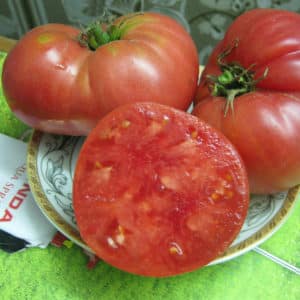 After ripening, large fruits have a distinctive bright crimson color. The tomatoes themselves have a good, round shape and can reach a weight of 500 grams in the first harvest; later, summer residents collect fruits weighing 300-400 g. The giant has a pronounced tomato taste, the fruit is juicy, sweet, dense, and sugary in structure. The dry matter content is approximately 5%, sugar – 2.4%, there are few seeds in the chambers.
After ripening, large fruits have a distinctive bright crimson color. The tomatoes themselves have a good, round shape and can reach a weight of 500 grams in the first harvest; later, summer residents collect fruits weighing 300-400 g. The giant has a pronounced tomato taste, the fruit is juicy, sweet, dense, and sugary in structure. The dry matter content is approximately 5%, sugar – 2.4%, there are few seeds in the chambers.
The crop tolerates transportation well even over long distances and can be stored for a long time. If you pick the fruit green or in “milk ripeness” and create optimal conditions of temperature and humidity (10-12 degrees Celsius and 80% humidity). The tomatoes will last until the new year. Thanks to these qualities, it is so loved by large manufacturers.
How to grow seedlings
If you follow simple rules planting and timely care, then a bountiful harvest on your table is guaranteed. The giant crimson is not very demanding to care for.
Seed preparation
Before planting seeds for seedlings, you need to prepare them. To do this, first soak them in a dark pink solution of potassium permanganate, but no longer than 40 minutes. Then the seeds should be placed in clean water and the liquid should be changed every three hours. The seeds should spend a day in such water. You can use a growth stimulator.
Then the seeds need to be dried on a paper napkin.. Fill the container for seedlings with nutritious soil and moisten it generously, place the dried seeds at a distance of 2-2.5 cm and sprinkle with soil to a height of one and a half centimeters. The container for seedlings must be covered with film until germination, but ventilated twice a day to prevent mold.
You need to start sowing seeds for seedlings 65-70 days before planting in the ground. (end of March - beginning of April). Most often they form a bush with two stems. After the first two leaves grow, it is necessary to pick the sprouts.
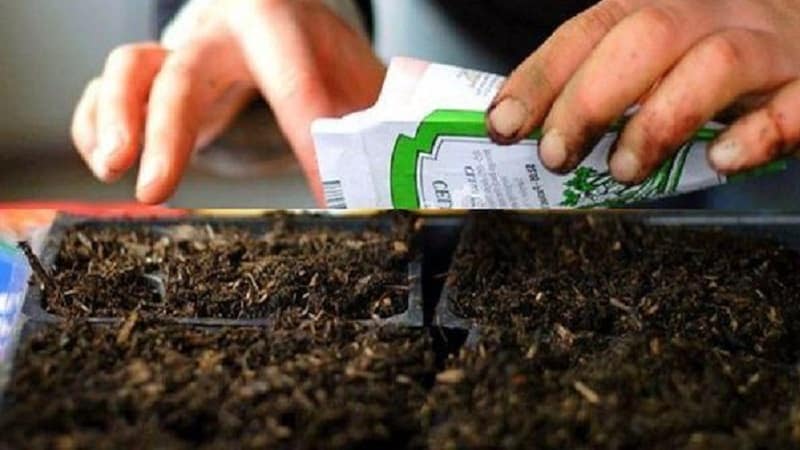
We grow seedlings
After the seeds germinate, the main thing is to water the soil on time., you can do this with a spoon between the sprouts or from a syringe, drop by drop. You need to place the container closer to the light; it is best to use special phytolamps for this so that the plant does not stretch in length, but grows strong.
If you plan to grow tomato bushes in open ground, then the seedlings need to be hardened: taken outside in cloudy weather, gradually increasing the time spent in the fresh air. Then begin to expose it to the sun, also for a short time at first, so that the plant does not get sunburn.
About other varieties of tomatoes:
Sustainable and productive tomato "Snowdrop" for the northern regions
Unpretentious, easy to care for and high-yielding tomato “Wind Rose”
Greenhouse or open ground?
Giant raspberry is a very heat-loving variety and also loves the sun's rays. Therefore, planting in open ground is possible only in the southern regions of Russia, such as: Astrakhan, Belgorod, Voronezh regions, the North Caucasus and Krasnodar Territory, Saratov Region.
In more northern areas, where there are often sharp changes in day and night temperatures, growing Giant is possible only in greenhouse conditions. This way you will control the heat flow. When setting up a greenhouse, you must remember that the plant is tall enough so that the grown Giant does not have to, like Atlas, prop up the ceiling of the greenhouse; its height should be at least two meters.
Planting and care
It is necessary to plant seedlings in the ground taking into account that adult plants are not crowded. The distance between seedlings should be at least half a meter, and more than four plants cannot grow on one square meter. Since the tomato bush of this variety is tall, it definitely needs a garter; this will also serve as additional protection if you plan to plant tomatoes in open ground.
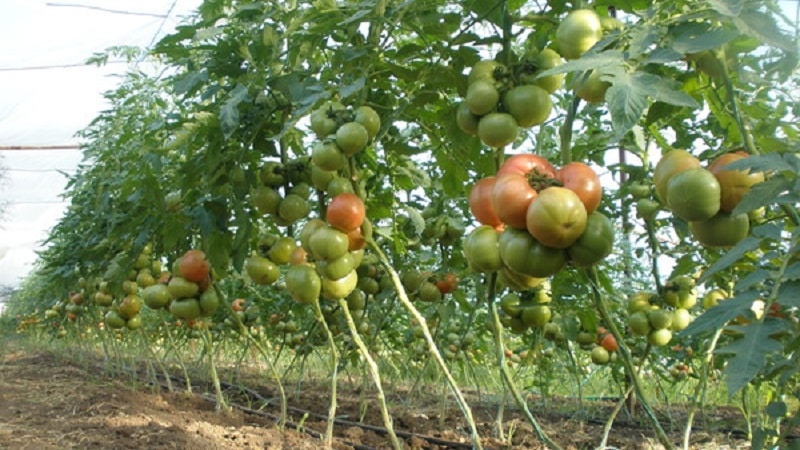
While the ovary is forming, this variety of tomatoes simply needs fertilizer containing potassium and phosphorus; during the growth process, the amount of feeding can be reduced.
In addition, the plant needs regular watering.
Lifehack. If it is not possible to water the soil frequently, but you want to avoid it drying out quickly, you can use mulching. A method learned from nature itself, when the soil is covered with a special mulch, preferably organic. In this case, not only will the soil not dry out and become crusty, but it will not have to be loosened often. And organic mulch, such as freshly cut grass, compost or straw, will also serve as fertilizer.
Stepsoning
In order not to turn your tomato beds into a jungle and to get a good harvest you need to do pinching. Beginner summer residents have questions: what are “stepchildren”, why remove them and how to do it correctly? Stepchildren are branches from the main stem, competing shoots. They appear from the leaf axil at the beginning of flowering. It is best to leave one of the most powerful ones, and remove all the others growing on it.
This can be done either with your hands, tearing it to the side and not down, so as not to damage the skin of the plant, or using garden shears.After each pruned plant, the scissors are washed in a solution of potassium permanganate so as not to spread the infection to the entire bush, if any.
It is best to plant plants once a week in the early morning on a sunny day., then the “wound” will have time to heal within a day. If the stepsons have not been picked for a long time and then decided to carry out the procedure in one day, then this will be a lot of stress for the bush.
Possible difficulties and features of cultivation
To ensure that there are no difficulties with growing a giant, you need to remove weeds in time and feed the seedlings with mineral fertilizers. The giant is sensitive to changes in air temperature and the forgetfulness of gardeners; the plant needs to be watered regularly.
A large number of sunny days is also extremely important for the variety., this affects the taste and sugar content of the future harvest. Despite the fact that this variety is not predisposed to diseases, it is still worth carrying out preventive measures: both against diseases and against pests.
Read also:
Tomato “Big Momma” and the secrets of growing large fruits
A unique hybrid with delicious fruits - the “Gift for a Woman” tomato
Diseases and pests
Most often, farmers planting this variety are faced with a disease such as tomato blossom end rot. To prevent this disease from destroying your future harvest, it is necessary to reduce the nitrogen content in the soil, monitor its moisture and fertilize the soil with calcium.
Damaged plants are sprayed with calcium nitrate solution. Another disease that can affect the giant raspberry tomato is brown spot; for prevention and treatment, you need to frequently ventilate the greenhouse, water less (not less often, but in smaller quantities) and adjust the temperature in the greenhouse.
Tomatoes of the Gigantic variety can be attacked by melon aphids and thripsTo prevent this from happening, you can use the “Bison” tool. They fight against mole crickets and slugs by loosening the soil, and you can also water the soil with a special solution: to do this, dilute a tablespoon of dry mustard or ground pepper in 10 liters of water.
Harvesting and application
Giant crimson has very good yield indicatorsOn average, farmers harvest 10 kg of tomatoes per bush, considering that three bushes per square meter equals 30 kg of tasty tomatoes.
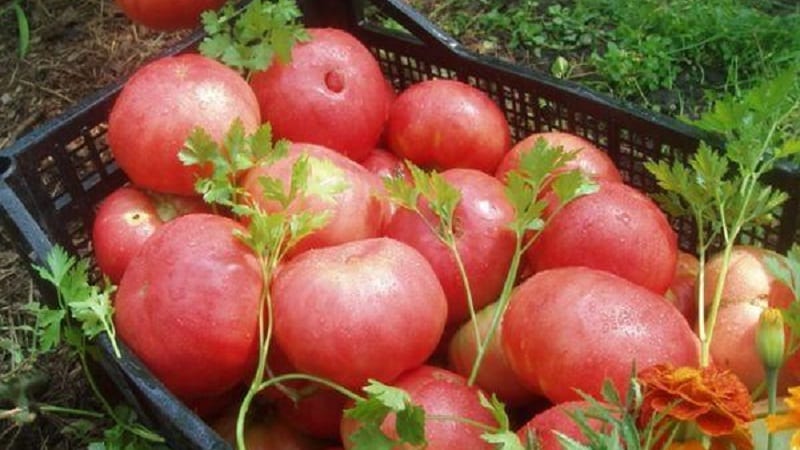
First harvest when the fruits reach half a kilogram in size, very good to eat fresh, as an ingredient in salads. The variety is perfect for making tomato paste and ketchup. But the subsequent harvest, with smaller fruits, will perform well in conservation and will allow you to enjoy the Giant all year round.
Advantages and disadvantages of the variety
It’s not for nothing that the giant raspberry is so popular among farmers, it main advantages:
- excellent taste;
- large fruits;
- good keeping quality.
Without fear, the fruits can be stored for a long time: in a cellar, closet, garage. In addition, thanks to their thick skin, they withstand the road well and are not afraid of transportation over long distances. Resistant to diseases and pests.
This variety has no disadvantages, there are growing features that you definitely need to pay attention to: the plant is heat-loving, loves the sun's rays, reacts sensitively if the watering schedule is violated and needs to be tied down, because it is quite tall.
Farmer reviews
Let's see how gardeners respond to growing tomatoes of this variety.
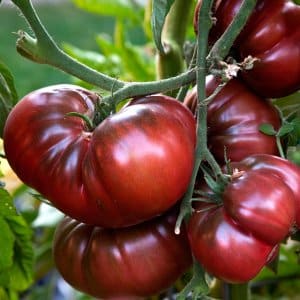 Alina Kornilova, 57 years old: “I have tried many varieties of tomatoes and have been growing Giant for several years now. My whole family loves the taste of these tomatoes. In the first year there were difficulties; I didn’t calculate the size of the bushes; they were uncomfortable in the greenhouse. But the very next season I took into account all the mistakes and got a very good harvest.”
Alina Kornilova, 57 years old: “I have tried many varieties of tomatoes and have been growing Giant for several years now. My whole family loves the taste of these tomatoes. In the first year there were difficulties; I didn’t calculate the size of the bushes; they were uncomfortable in the greenhouse. But the very next season I took into account all the mistakes and got a very good harvest.”
Dmitry Semenov, 42 years old: “I live in the Krasnodar region, I grew Giant Raspberry in open ground. What pleased me most was that there were no problems with pests, the main thing is not to forget to tie up the bushes - when there is a lot of sun and warmth, the bushes grow huge. They ate the first harvest like this, and the smaller ones that came later were salted.”
Irina Vyseltseva, 67 years old: “A friend recommended this variety to me and treated me to her tomatoes. I really liked them and decided to grow them too. There weren’t any particular problems; I’m an experienced gardener. I can only advise using mineral fertilizers first.”
Conclusion
The giant crimson allows you to enjoy not only the harvest (and it pleases with its truly gigantic size) but also the process itself. The variety is easy to care for and is not susceptible to diseases and pests. The main thing is to remember that planting in open ground is possible only in the southern regions, but you can also get excellent results in a greenhouse.
Follow the watering schedule, don’t forget to plant and tie up mature bushes, and then gigantic tomatoes will not keep you waiting.